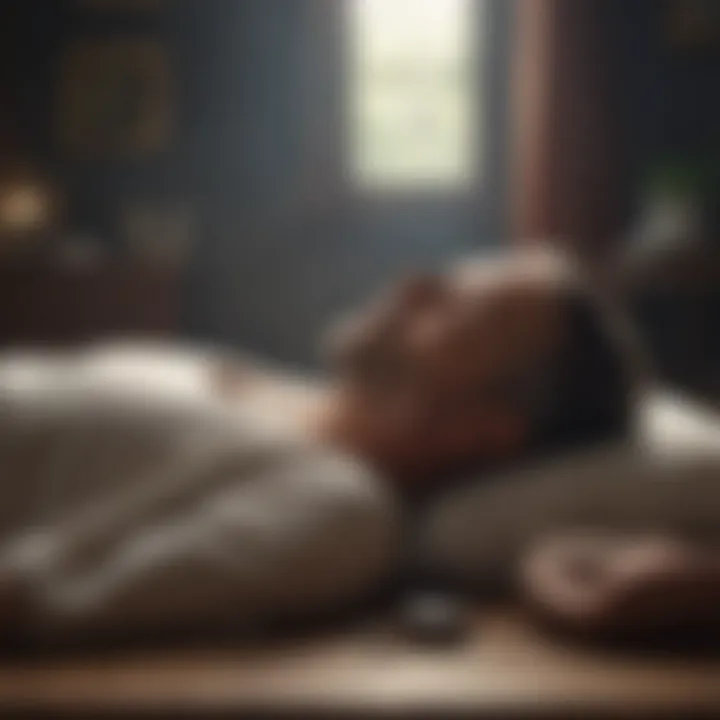Rapid Sleep Onset: Effective Strategies for Better Rest


Intro
Sleep is a fundamental aspect of human health, impacting mental and physical well-being. However, many individuals struggle to fall asleep quickly. This article delves into effective strategies that can aid in rapid sleep onset. By reframing our approach to bedtime, we can create a more relaxed environment conducive to sleep. The focus extends to behavioral changes, environmental factors, and mental strategies that collectively enhance sleep quality.
Types of Guided Meditation
Guided meditation has emerged as a popular tool for fostering better sleep. It often includes structured practices that help individuals transition into a restful state. The two prominent types are Mindfulness Meditation and Sleep Meditation.
Mindfulness Meditation
Mindfulness meditation emphasizes awareness of the present moment. Through focused attention on breath and bodily sensations, it encourages practitioners to acknowledge their thoughts without judgment. This process can reduce anxiety and calm the mind, making it easier to drift into sleep.
Sleep Meditation
Sleep meditation is specifically designed to promote faster sleep onset. This practice typically features soothing music or calming spoken instructions that guide the listener toward relaxation. Often incorporating visualization techniques, sleep meditation can divert the mind from racing thoughts, leading to a peaceful transition into sleep.
Benefits of Guided Meditation
The adoption of guided meditation can yield several key benefits for individuals seeking improved sleep.
Mental Clarity and Focus
Practicing meditation regularly can enhance mental clarity and focus. By training the mind to stay present, individuals may find that their thought patterns become less chaotic.
Improved Sleep Quality
Guided meditation has been linked to improved sleep quality. Those who engage in these practices often report falling asleep faster and experiencing deeper, more restorative sleep. This connection to sleep quality underscores the significance of incorporating guided meditation as part of a broader sleep improvement strategy.
"Meditation can help create the mental environment needed for restful sleep, offering a solution to those with sleep difficulties."
Incorporating these meditation techniques into a nightly routine can be beneficial. Simple adjustments and practices can create an atmosphere conducive to rapid sleep onset. Focusing on both the mind and the environment can lead to significant improvements in sleep quality, ultimately enhancing overall well-being.
Understanding Sleep and Its Importance
Sleep is a fundamental aspect of human health, yet many underestimate its significance. Good sleep is crucial for physical, mental, and emotional well-being. Without sufficient rest, various bodily functions can falter.
The relationship between sleep and overall health is complex and intricate. The body requires sleep not only to recover but also to process information, regulate hormones, and maintain immune functions. When we overlook the importance of sleep, we risk not just temporary fatigue but also long-term health issues.
The Science of Sleep
Sleep is a biological state characterized by alterations in consciousness, sensory activity, and muscle mobility. The sleep cycle consists of different stages, primarily divided into REM (Rapid Eye Movement) and non-REM sleep. In these stages, the body's restorative processes occur, such as tissue repair and memory consolidation. Recent research shows how vital deep sleep is for cognitive function, impacting learning and memory performance.
Sleep cycles generally follow a pattern and can last from 90 to 110 minutes. Each cycle plays a critical role in how refreshed a person feels upon awakening.
Consequences of Sleep Deprivation
Lack of adequate sleep extends beyond daily tiredness. Acute sleep deprivation can impair cognitive functions, causing issues in decision-making, attention, and reaction times. Chronic sleep deprivation has shown links to serious health conditions, including obesity, diabetes, cardiovascular diseases, and even certain cancers. Moreover, the mental health implications can not be overlooked; anxiety and depression often correlate with poor sleep patterns.
"Sleep is not just a break from life, but a necessity for healthy living."
A consistent lack of sleep can also affect relationships due to irritability and mood swings, highlighting how interconnected sleep is with personal interactions and social well-being.
Optimal Sleep Duration Recommendations
Understanding sleep duration is vital for individual health. While needs differ, general guidelines suggest that adults require 7 to 9 hours each night. Infants and teenagers need substantially more to support their growth and development. Individual variations depend on genetics, lifestyle, and specific health issues.
Here’s a simple breakdown of recommended sleep durations:
- Newborns (0-3 months): 14-17 hours
- Infants (4-11 months): 12-15 hours
- Toddlers (1-2 years): 11-14 hours
- Preschoolers (3-5 years): 10-13 hours
- School-age children (6-13 years): 9-11 hours
- Teenagers (14-17 years): 8-10 hours
- Adults (18-64 years): 7-9 hours
- Older adults (65+ years): 7-8 hours
Finding the optimal sleep duration for oneself promotes better health, reduced stress, and increased productivity. Recognizing one’s own pattern could be the first step toward achieving sound sleep habits.
Behavioral Techniques for Sleep Improvement
Behavioral techniques are imperative in the pursuit of improved sleep. They serve as foundational habits to promote better sleep hygiene, which is essential for effective sleep onset. Understanding and applying these techniques can significantly influence one's ability to fall asleep quickly and maintain healthy sleep patterns. Strategies range from modifying daily routines to adjustments in evening behaviors, all aimed at enhancing sleep quality.
Establishing a Consistent Sleep Schedule
A consistent sleep schedule lays the groundwork for good sleep. Going to bed and waking up at the same time every day, including weekends, helps regulate the body's internal clock. This regularity can enhance both sleep quality and duration. When people adhere to a consistent schedule, the body becomes more adept at recognizing when it is time to sleep, leading to faster sleep onset.
In establishing this routine, individuals should aim to limit any deviations. If one is known to stay up late or vary wake-up times, monitoring this behavior is crucial for improvement. One could use mobile alarms or calendar notifications as reminders.
Limiting Stimulants in the Evening
Limiting stimulants in the evening is crucial for those seeking a smooth transition to sleep. Substances like caffeine and nicotine can interfere with the body's ability to wind down. Caffeine, commonly found in coffee, tea, and chocolate, can take several hours to leave the system. Therefore, it is advisable to avoid these stimulants in the late afternoon and evening.
Similarly, nicotine, found in cigarettes or other products, should be avoided as it is a stimulant that can lead to increased heart rate and alertness. Reducing the intake of these stimulants can result in a more relaxed state as bedtime approaches, easing the pathway to sleep.
Pre-Sleep Activities to Avoid
Certain pre-sleep activities can hinder the ability to fall asleep quickly. Engaging in vigorous exercise or stimulating activities such as intense video games can contribute to heightened alertness, making it challenging to relax. Ideally, individuals should avoid heavy workouts within a few hours of sleep.
Additionally, exposure to screens from phones, tablets, or televisions can disrupt the production of melatonin, a hormone that facilitates sleep. Blue light emitted from these devices signals the brain to remain awake. It is advisable to limit these activities prior to bedtime and instead opt for calming alternatives, such as reading or meditation.
"Creating a dedicated wind-down period before sleep can drastically enhance sleep onset efficiency."
Creating a Sleep-Inducing Environment
Creating a sleep-inducing environment is critical for anyone seeking to improve their sleep quality. The surroundings in which one sleeps can make a significant impact on how quickly someone falls asleep and how restful that sleep is. By thoughtfully arranging the bedroom and minimizing potential distractions, individuals can cultivate a space that promotes relaxation and restorative sleep. This part of the article will explore essential elements to consider for establishing such an environment more effectively.
Optimal Bedroom Conditions


The foundational aspect of a sleep-friendly space includes maintaining optimal bedroom conditions. This involves several factors that contribute to physical comfort and psychological relaxation. Key elements include temperature, bedding, and noise levels.
- Temperature Control: The ideal sleep temperature is often reported to be between 60°F and 67°F (15°C and 19°C). Keeping the room cool helps the body to lower its core temperature, which is necessary for sleep onset. Consider using a fan or air conditioning to maintain the preferred climate.
- Quality of Bedding: Investing in a comfortable mattress and pillows can profoundly affect sleep. A mattress that is too firm or too soft may lead to discomfort and disrupted sleep patterns. Additionally, using breathable bedding materials can help in regulating body heat throughout the night.
- Minimizing Clutter: A tidy room can foster a calm mindset. Organizing personal items and minimizing noise contributions from outside or electronic devices will encourage relaxation.
Technological Distractions to Minimize
Technological distractions are pervasive in today’s society and can inhibit the ability to fall asleep quickly. Devices such as smartphones, laptops, and televisions contribute to sleep disturbances in various ways.
- Screen Time: The blue light emitted from screens can interfere with melatonin production, making it harder for the body to transition into sleep. It is advisable to turn off devices at least an hour before bedtime to allow the natural sleep cycle to take over.
- Notifications and Alerts: Constant alerts can lead to interruptions during sleep. Setting phones to silent and removing gadgets from the bedroom can reduce these frustrations. Consider charging devices in another room entirely.
The Role of Light and Sound
Light and sound play pivotal roles in sleep quality, influencing both sleep onset and its maintenance. Understanding how to manipulate these elements can lead to significant improvements in sleep patterns.
- Light Exposure: Exposure to natural light during the day aids the body's natural circadian rhythms. In the evening, minimizing artificial light is equally important. Using blackout curtains can obstruct unwanted light from outside, creating a dark environment that enhances melatonin production.
- Sound Management: Noise can disrupt sleep cycles, especially sudden or loud sounds. Utilizing white noise machines or apps can help mask disruptive noises. For others, soothing sounds like gentle rain or ocean waves can create a calm atmosphere conducive to falling asleep.
"Creating a tranquil environment, free from distractions, significantly promotes quicker sleep onset and improved overall rest."
Mindfulness and Relaxation Techniques
Mindfulness and relaxation techniques play a critical role in facilitating rapid sleep onset. These methods help reduce mental chatter, lower stress levels, and prepare the mind for sleep. By integrating these practices into a nightly routine, individuals can significantly improve their ability to fall asleep quickly. Emphasizing both physiological and psychological benefits, mindfulness techniques help create a sense of calm that is essential for a restful night.
Practicing mindfulness encourages individuals to focus on the present moment without judgment. This can be particularly helpful for those whose minds race with worries and distractions at bedtime. Additionally, relaxation techniques such as breathing exercises and progressive muscle relaxation reduce muscle tension and physical stress, further promoting a tranquil state conducive to sleep. Overall, these practices can serve as powerful tools in the quest for better sleep.
Breathing Exercises for Calmness
Breathing exercises are simple yet effective strategies for inducing calmness and preparing the body for sleep. Deep, controlled breathing activates the parasympathetic nervous system, leading to relaxation and a decrease in heart rate. One effective method is the 4-7-8 breathing technique. In this practice, you inhale for four seconds through your nose, hold your breath for seven seconds, then exhale slowly through your mouth for eight seconds.
This rhythmic pattern not only slows your heart rate but also shift your focus from the stressors of the day to the act of breathing. It creates a physiological response that promotes a sense of calm. Regular practice of this technique may help individuals form a habit that signals their body it is time to sleep.
Progressive Muscle Relaxation
Progressive muscle relaxation (PMR) is another technique aimed at relieving tension in the body. This method involves systematically tensing and then relaxing different muscle groups, starting from the toes and moving up to the head. By paying attention to the sensations in each muscle group, individuals can develop a heightened awareness of physical tension and learn to release it.
- Begin by lying in a comfortable position.
- Starting with your toes, tense the muscles as you inhale for five seconds.
- Release the tension as you exhale, noticing the difference in sensation.
- Move sequentially through the body, from feet to head.
Practicing PMR helps establish a connection between the mind and body, making it easier to let go of stress and transition into sleep. Many find this technique to be particularly effective when paired with specific breathing exercises to enhance relaxation.
Guided Imagery Practices
Guided imagery practices combine visualization and relaxation to create a soothing mental escape. This method involves picturing a serene environment or peaceful scenario, which helps divert attention from racing thoughts. To practice guided imagery:
- Find a quiet place where you can relax without interruptions.
- Close your eyes and breathe deeply to settle your mind.
- Imagine a tranquil scene, such as a beach, forest, or any place that feels calming.
- Engage all your senses; notice the colors, sounds, and sensations of that place.
Through this focused visualization, individuals can effectively transport their mind away from stressors. This practice can reduce anxiety, promote relaxation, and facilitate a smoother transition to sleep. Guided imagery allows one to cultivate a peaceful mental space, making it easier to embrace sleep.
Mindfulness and relaxation techniques serve as valuable tools in achieving restful sleep, allowing individuals to quiet their minds and lay the groundwork for a good night’s rest.
The Impact of Nutrition on Sleep
Nutrition plays a critical role in determining sleep quality and speed of onset. What we eat directly affects our body's ability to rest and rejuvenate. By understanding how different foods influence our sleep, individuals can make informed choices that promote faster sleep onset and better overall sleep quality.
Healthy eating habits not only contribute to physical health but can also improve mental well-being and sleep patterns. Certain foods contain nutrients that can aid in relaxation, while others may disrupt sleep. The timing of meals also holds significance, as consuming food too close to bedtime can interfere with the body's ability to settle down for the night. Moreover, proper hydration is essential; both over-hydration and dehydration can have adverse effects on sleep.
Foods That Promote Sleep
Select foods with sleep-promoting properties can enhance the body's ability to fall asleep. Here are some key players:
- Turkey: Rich in tryptophan, which the body uses to produce melatonin, a hormone necessary for sleep regulation.
- Almonds: High in magnesium, which may help calm the nervous system and promote sleep.
- Kiwi: Packed with antioxidants and serotonin, studies suggest kiwis may help with faster sleep onset.
- Fatty Fish: Fish like salmon and mackerel are rich in omega-3 fatty acids and vitamin D, which may help regulate serotonin levels.
- Oatmeal: Contains melatonin, plus carbohydrates that can enhance the availability of tryptophan.
Adding these foods to your diet might help induce more restful nights.
Timing of Meals and Its Effects
The timing of when meals are consumed can significantly impact sleep. Eating heavy meals late in the evening can lead to discomfort and indigestion, both detrimental to quality rest. Here are a few considerations:
- Plan your last meal: Aim to finish eating at least two to three hours before bedtime to allow your body time to digest.
- Avoid high-sugar foods: Sugary snacks can spike energy levels, making it harder to wind down at night.
- Smaller evening meals: Consider lighter meals in the evening to minimize digestive burden and promote more comfortable sleep.
Aligning meal timings with sleep schedules will help create a more conducive environment for resting.
Hydration and Sleep Quality
Hydration is essential for overall bodily function, but it also affects sleep quality. Balance is key:
- Too much water before bed can lead to frequent bathroom trips, disrupting sleep cycles.
- Dehydration, on the other hand, may lead to discomfort, dry mouth, and even headaches, which can be equally disruptive.
- Ideal hydration strategy: Aim to hydrate well throughout the day and reduce fluid intake as bedtime approaches.
By focusing on hydration levels, individuals can further enhance their sleep experience.
Understanding the link between nutrition and sleep can take one step closer to achieving quality rest. A few small changes in dietary habits may result in significant improvements.
Utilizing Technology for Sleep Aids
In the modern world, technology has become an integral component of our daily lives. When it comes to sleep, various technological advancements can aid in achieving rapid sleep onset and improving overall sleep quality. By leveraging these tools, individuals can create a personalized sleep strategy that aligns with their needs. The significance of utilizing technology lies in its ability to provide insightful data, promote relaxation, and enhance environmental conditions conducive to sleep.
Apps for Sleep Tracking
Sleep tracking apps have gained popularity for their ability to monitor sleep patterns. These applications offer insights into the duration and quality of sleep. They track movement, sounds, and even heart rate, allowing users to understand their sleep cycles better. Some notable benefits of sleep tracking apps include:
- Data Analysis: Users can view their sleep trends over time. Analyzing this data helps identify factors that may be disrupting sleep.
- Goal Setting: With accurate information, individuals can set realistic sleep goals to improve their habits.
- Integration with Other Tools: Many apps sync with wearable devices like smartwatches for enhanced tracking capabilities.
Examples of popular sleep tracking apps include Sleep Cycle and Fitbit. These tools help people become more aware of their sleep habits, making it easier to implement necessary changes for better sleep.


Sleep Meditation and Relaxation Audio
Another technological advancement designed to promote sleep involves audio resources focused on meditation and relaxation. Audio programs, such as those available on apps like Calm and Headspace, guide users through sleep meditations. These sessions often include soothing sounds, gentle instructions, and calming narratives. The benefits of using relaxation audio are notable:
- Stress Reduction: Listening to guided meditations can effectively reduce anxiety and stress levels, making it easier to unwind at the end of the day.
- Focus on Breathing: These programs typically emphasize breathing techniques which can help slow down the heart rate and calm the mind.
- Environment Creation: Soothing audio creates a serene atmosphere that can be more conducive to sleep compared to silence or disruptive noises.
By employing audio strategies, users can find a path to relaxation that suits them, ultimately leading to quicker sleep onset.
Smart Devices for Environment Control
Smart devices have transformed how we manage our sleeping environments. These technologies enable individuals to create settings that support better sleep. Some prominent examples include:
- Smart Thermostats: Devices like Nest can be programmed to lower the temperature during the night, which studies show can increase sleep quality.
- Smart Lamps: These adjustable lights simulate natural light cycles, promoting alertness during the day and reducing brightness in the evening to facilitate melatonin production.
- White Noise Machines: Using machines that emit white noise or soothing sounds can help drown out distracting noises that might interrupt sleep.
Implementing smart devices can lead to a more controllable and tailored sleep environment. The integration of such technology is an important step in adopting a forward-looking approach to sleep hygiene.
Technology offers new solutions for sleep challenges. Adapting to these tools can improve sleep quality remarkably.
In summary, technology provides numerous opportunities to enhance sleep experiences. By using sleep tracking apps, relaxation audio, and smart devices, individuals can take significant steps toward achieving rapid sleep onset and better overall health.
Addressing Underlying Sleep Disorders
Addressing underlying sleep disorders is critical in the quest for rapid sleep onset. Many individuals experience difficulties falling asleep that are linked to specific disorders, including insomnia, sleep apnea, and restless leg syndrome. Recognizing and addressing these conditions is essential as they can significantly impair not just sleep quality but also overall health. A proactive approach can lead to better sleep efficiency, enhancing daytime functioning and mental clarity.
Common Sleep Disorders Overview
Sleep disorders are varied and can affect individuals in multiple ways. Here are some of the common disorders:
- Insomnia: Characterized by difficulty falling asleep or staying asleep, insomnia may be acute or chronic. It often leads to daytime fatigue and irritability.
- Sleep Apnea: This condition involves interrupted breathing during sleep. It can lead to loud snoring and numerous awakenings, compromising sleep quality.
- Restless Leg Syndrome: This condition causes an uncomfortable urge to move the legs, often hindering the ability to fall or stay asleep.
- Narcolepsy: A neurological disorder that affects the brain’s ability to control sleep-wake cycles. People with narcolepsy might experience sudden sleep attacks and excessive daytime sleepiness.
When to Seek Professional Help
Knowing when to seek professional help can be crucial in managing sleep disorders. Here are some indicators:
- Persistent sleep disturbances lasting more than a few weeks.
- Excessive daytime sleepiness impacting daily activities.
- Loud snoring or periods of choking during sleep.
- Difficulty concentrating due to poor sleep quality.
Consulting a healthcare professional can shed light on the nature of the sleep issue. They may perform a sleep study or other evaluations to determine the underlying cause more effectively.
Cognitive Behavioral Therapy for Insomnia
Cognitive Behavioral Therapy (CBT) is a structured program that helps individuals identify and change thoughts and behaviors contributing to insomnia. It often includes the following components:
- Sleep Restriction Therapy: Limiting the amount of time spent in bed to improve sleep efficiency.
- Stimulus Control: Associating the bed strictly with sleep, enhancing the connection between the bed and the act of sleeping.
- Cognitive Restructuring: Challenging and changing negative thoughts surrounding sleep and insomnia.
CBT for insomnia has shown effectiveness in both the short term and long term, making it a viable option for those struggling with sleep dysfunctions. Using CBT techniques may not only provide immediate assistance but also foster long-lasting habits for improving sleep.
Effective management of sleep disorders can lead to clearer thinking and better health on a daily basis.
\nIn conclusion, addressing underlying sleep disorders is pivotal for achieving rapid sleep onset. Understanding common disorders, recognizing when to seek help, and utilizing effective therapies like CBT can transform sleep quality significantly.
Practical Tips for Immediate Sleep Assistance
Napping Wisely
Napping can be a double-edged sword; it has both potential benefits and drawbacks. A well-timed nap can enhance alertness, cognitive function, and overall mood. However, napping indiscriminately can disrupt nighttime sleep patterns. For effective napping, aim for short, strategic intervals. Typically, a duration of 20 to 30 minutes is ideal. This is long enough to experience sleep benefits but short enough to avoid entering deeper sleep stages, which can leave you feeling groggy. It is also advisable to nap earlier in the day. Napping later can interfere with your ability to fall asleep at your normal bedtime.
Short Wind-Down Routine Before Sleep
Developing a brief wind-down routine is essential for preparing the body and mind for sleep. This routine can include calming activities that signal to your body that it is time to rest. A span of 20 to 30 minutes is usually suitable. Consider integrating practices such as reading a book, gentle stretching, or listening to soft music. Ensure that these activities are relaxing and do not involve screens. Bright screens can confuse the body’s natural cues for sleep by emitting blue light. Light dimming in this period can also assist in encouraging sleepiness as it aligns physical cues closer to nighttime behavior.
Using Aromatherapy for Relaxation
Aromatherapy can play a significant role in fostering an atmosphere that promotes sleep. Specific scents, such as lavender and chamomile, are known for their calming properties. Incorporating these into your pre-sleep rituals can be effective. This can be as simple as using essential oil diffusers or applying a few drops to your pillow. The key is to create an olfactory environment that encourages relaxation. Be mindful of any allergies or sensitivities to scents, ensuring that the atmosphere remains pleasant and not overwhelming.
"Establishing a routine and incorporating calming scents can significantly improve the quality of one's sleep experience."
Ultimately, the goal is to create a welcoming atmosphere and practice that nudges you toward sleep. By integrating these tips, you can offer your body immediate pathways to relaxation, setting a strong foundation for a restful night. Combining these strategies effectively can make a meaningful difference in how quickly you transition into slumber.
The Role of Physical Activity
In recent studies, researchers have found a clear connection between exercise and sleep. Exercise, particularly moderate aerobic activities, can help reduce insomnia and promote more restorative sleep cycles. When considering physical activity for sleep benefits, both the type and timing of exercise play crucial roles in its effectiveness.
Exercise Timing and Its Effects on Sleep
The timing of physical activity significantly impacts how it affects sleep. Exercise performed too close to bedtime may interfere with the body's ability to wind down. Engaging in vigorous activities late in the evening raises the heart rate and stimulates the body, making it harder to achieve a relaxed state for sleep. On the other hand, exercising earlier in the day can facilitate the release of neurotransmitters that promote a sense of calmness, thereby easing the transition into sleep later in the evening.
Another important consideration is the consistency of exercise timing. Maintaining a routine that includes regular physical activity at similar times daily can help in regulating the body's internal clock. Aligning your exercise schedule with natural circadian rhythms can optimize sleep onset and improve overall sleep quality.
Types of Exercise That Promote Sleep
Different variations of exercise yield varying benefits when it comes to sleep. Here are a few types that are particularly effective:
- Aerobic Exercise: Activities like running, swimming, or cycling can improve sleep duration and quality. Engaging in aerobic workouts at least three times a week has shown beneficial effects.
- Strength Training: Resistance training not only enhances physical fitness but also contributes to deeper sleep. It is advisable to incorporate it into your weekly routine.
- Low-Intensity Exercises: Gentle activities, such as walking or leisurely cycling, can help reduce anxiety and promote relaxation, leading to improved sleep.
"Physical activity, such as aerobic exercise, can enhance sleep quality and facilitate a quicker onset of sleep."
Incorporating a mix of these exercises throughout the week can provide a balanced approach that maximizes sleep benefits while maintaining physical health.
Restorative Practices: Yoga and Stretching
Restorative practices such as yoga and stretching are vital for those seeking quicker sleep onset. These low-impact activities can significantly reduce muscle tension, alleviate stress, and promote relaxation. Yoga, in particular, has been researched for its sleep-enhancing properties, as various poses are known to calm the nervous system.
Some effective yoga poses include:


- Child’s Pose: This pose encourages relaxation and is beneficial for calming the mind.
- Legs Up the Wall: A restorative pose that promotes circulation and relaxation.
- Corpse Pose: A final resting posture that integrates breathing and relaxation, conducive for sleep.
The Psychological Aspect of Sleep
The relationship between our psychological state and sleep is significant. Understanding this connection can lead to better sleep quality. Often, stress and anxiety can impede our ability to fall asleep. For many, the mind races when it is time to rest, creating barriers to sleep onset. Thus, addressing these psychological factors is crucial for effective sleep strategies.
Managing Anxiety and Stress for Better Sleep
Anxiety and stress are common issues many encounter in daily life. These feelings can significantly impact our sleep patterns. When individuals are under stress, cortisol levels increase. This hormone is linked to alertness, making it difficult to fall asleep. To combat this, it is essential to find suitable stress management techniques.
- Breathing Techniques: Controlled breathing can help reduce anxiety. Deep inhaling through the nose, holding briefly, and exhaling through the mouth promotes calmness.
- Mindfulness Meditation: Spending a few minutes in mindfulness meditation can clear the mind. This technique encourages focusing on the present moment, allowing thoughts to settle before bedtime.
- Journaling: Writing down concerns or tasks before bed can release mental burdens. This practice often leads to a clearer mind, reducing anxiety levels prior to sleep.
By employing these methods, individuals can manage anxiety and pave the way for improved sleep.
Cognitive Techniques for Reducing Racing Thoughts
Many individuals face racing thoughts when trying to sleep. Such disruptiveness can keep one awake for extended periods. Implementing cognitive techniques can help address this issue effectively.
- Cognitive Behavioral Therapy (CBT): This method targets negative thought patterns. By restructuring these thoughts, individuals can foster a more peaceful mindset conducive to sleep.
- Visualization: Imagining calming scenes helps redirect focus away from persistent thoughts. This mental imagery can relax the mind, making sleep onset more achievable.
- Setting Time Limits: Allocating a specific period to deal with worries can create boundaries. This approach ensures that thoughts do not overwhelm the entire night, thus promoting relaxation.
Creating a Positive Sleep Mindset
A positive sleep mindset plays a vital role in the sleep experience. Shifting perceptions about sleep can significantly enhance relaxation.
- Affirmations: Positive affirmations can reshape thoughts around sleep. Phrases like "I am capable of falling asleep" can build confidence in one's ability to rest.
- Limiting Sleep Pressure: Understanding that one does not have to stress about sleep can be liberating. Approaching sleep without pressure can actually minimize sleep anxiety.
- Establishing Rituals: Creating a pre-sleep ritual can signal the brain that it is time for rest. This routine might include gentler activities like reading or taking a warm bath.
"Developing a positive relationship with sleep improves the odds of falling asleep quickly."
The Importance of Daylight Exposure
The connection between daylight exposure and sleep is profound yet often overlooked. In this section, we will explore how exposure to natural light plays a crucial role in regulating sleep patterns and maintaining overall health. The inclusion of adequate daylight within the daily routine not only affects mood but also shapes circadian rhythms, ultimately streaming into the quality of sleep one can achieve.
Households with minimal sunlight exposure may experience altered sleep cycles, leading to insomnia or difficulties with sleep onset. Thus, it is imperative to integrate more natural light into daily life. The advantages of this can be numerous, such as improved mood, better sleep quality, and enhanced cognitive function.
Natural Light and Circadian Rhythm
Circadian rhythm is the body's internal clock, regulating the sleep-wake cycle over a 24-hour period. Natural light is instrumental in syncing this rhythm. The presence of brightness during the day encourages active biological functions, signaling to the body that it is time to be alert. Conversely, reduced exposure to light, particularly blue light in the evening, prepares the body for rest.
Studies emphasize that exposure to natural light during daylight hours significantly boosts melatonin production at night. This hormone is vital for sleep onset as it facilitates a transition into a restful state. For people struggling with rapid sleep onset, understanding this relationship can lead to implementing better light exposure strategies in their daily lives.
Balancing Daylight and Darkness for Sleep Regulation
Achieving a balance between daylight and darkness is crucial for sleep regulation. Too much exposure to artificial light during the evening can hinder the onset of sleep. Incorporating daylight exposure during the day and minimizing light during nighttime creates a conducive environment for sleeping.
- Morning Routine: Start the day by spending time outdoors, preferably in natural light. A morning walk can help set a positive tone for sleep later in the day.
- Limit Screen Time: Reduce exposure to bright screens in the hours leading to bedtime. Instead, opt for dim lighting and relaxing activities.
- Create a Dark Bedroom: At night, ensure your sleeping environment is as dark as possible, blocking out any external light that may disrupt sleep.
"Natural light is not a luxury; it is a necessity for optimal health and well-being."
In summary, understanding the importance of daylight exposure is essential for anyone seeking efficient sleep strategies. By managing natural light intake and ensuring proper darkness during sleeping hours, one can make significant improvements toward achieving better sleep health.
Exploring Sleep Aids: Herbal and Natural Supplements
The exploration of sleep aids, specifically herbal and natural supplements, plays a crucial role in understanding how to achieve faster sleep onset. Many individuals struggle with sleep-related issues, and while behavioral changes and environmental adjustments are always recommended, supplements can offer additional support. Herbal remedies have been traditionally recognized for their calming properties and may provide benefits such as reduced anxiety and improved sleep quality.
Understanding the effects of these natural supplements can empower individuals in their quest for better sleep. Knowledge about the specific herbs, their potential benefits, and considerations for use can enhance one's overall approach to sleep health.
Common Herbal Remedies for Sleep
There are various herbal remedies known to aid sleep. Some of them include:
- Valerian Root: Valerian has been widely used for its sedative effects. It may help reduce the time it takes to fall asleep and improve sleep quality. However, the effectiveness can vary from person to person.
- Chamomile: Chamomile tea is a popular choice for promoting relaxation. Studies suggest that it may enhance sleep quality and reduce insomnia symptoms, although rigorous clinical evidence is still limited.
- Lavender: Often used in aromatherapy, lavender can create a calming atmosphere. Research indicates that lavender oil may increase slow-wave sleep and decrease sleep disturbances.
- Passionflower: This herb is linked with anxiety reduction, which could be beneficial for sleep onset. Some small studies suggest it may improve sleep quality and decrease nighttime awakenings.
- Lemon Balm: Lemon balm, often used in combination with other herbs, has a mild sedative effect and may help in reducing anxiety and enhancing sleep quality.
These herbal remedies can be effective for many, but their interactions with other medications and unique individual responses necessitate caution and consultation with a healthcare professional before usage.
Safety Considerations for Sleep Aids
While herbal and natural supplements may offer promise, safety is a paramount concern. Here are important aspects to consider when using sleep aids:
- Consultation with Healthcare Providers: It is essential to consult with a qualified healthcare provider before starting any herbal supplement, especially for those with pre-existing conditions or who are pregnant or nursing.
- Potential Interactions: Herbal supplements can interact with prescription medications, leading to unwanted side effects. Understanding these interactions is critical for safe usage.
- Dosage and Purity: The appropriate dosage can vary by individual and product quality. Always opt for reputable brands that provide standardized extracts and clearly labeled dosages.
- Monitoring Effects: Individuals should carefully monitor their reactions to any new supplement. If adverse effects occur, it may be necessary to discontinue use immediately.
"Natural does not always mean safe; understanding the potential risks and benefits is essential for using herbal remedies effectively."
Long-term Strategies for Sustained Sleep Health
Long-term strategies for sustained sleep health are fundamental for individuals seeking to improve their overall well-being. Sleep is not merely a nighttime activity; it is an essential biological process that impacts physical health, mental clarity, and emotional stability. Investing effort into long-lasting changes can lead to consistent improvements in sleep quality, ensuring that individuals feel rejuvenated each morning.
Adopting a Holistic Approach to Sleep
A holistic approach means addressing all factors that impact sleep. This perspective integrates various elements, such as physical well-being, emotional health, and environmental influences. People often overlook how interconnected these aspects are. For instance, poor nutrition can lead to sleep disturbances. Likewise, untreated anxiety or stress can obstruct the ability to fall asleep quickly.
Key components of a holistic approach include:
- Balanced Nutrition: Diet plays a significant role. Foods rich in magnesium, like spinach, and tryptophan, such as turkey, can aid sleep.
- Adequate Physical Activity: Regular exercise promotes the release of endorphins and reduces stress. However, timing matters; vigorous exercise close to bedtime may hinder sleep onset.
- Stress Management Techniques: Incorporating practices like yoga or meditation can help manage stress levels and promote relaxation before sleep.
This holistic methodology encourages individuals to evaluate their lifestyles comprehensively, creating a synergy that promotes better sleep patterns.
Regular Assessment of Sleep Quality
Monitoring sleep quality involves keeping track of how well one sleeps over time. This process can highlight patterns or habits that contribute to either good or poor sleep. Regular assessments can help identify specific issues that might require intervention.
To assess sleep quality effectively, consider the following steps:
- Sleep Diary: Maintain a record of sleep times, wake times, and how rested you feel each morning. This can reveal trends linked to poor sleep.
- Sleep Quality Metrics: Use sleep tracking devices or apps to gain a more objective view of sleep cycles and disturbances.
- Feedback Mechanism: Periodically reflect on lifestyle changes and their impacts on sleep. Adjustments should be made as needed.
"Consistent evaluation of sleep quality can unlock solutions to chronic sleep issues that might otherwise be overlooked."
Ultimately, combining both a holistic approach and regular evaluations forms the foundation for sustained sleep health. Implementing these strategies does not require drastic changes, but rather consistent efforts and an open mind to adapt. Individuals can achieve fulfilling rest and improve their daily functioning by being mindful of these aspects.







